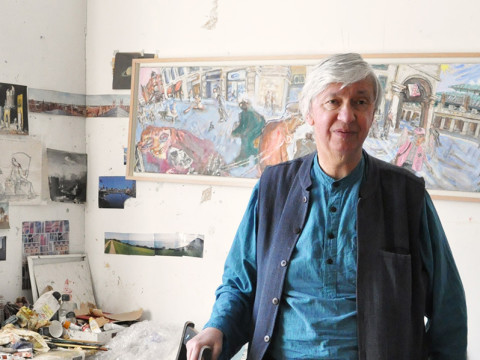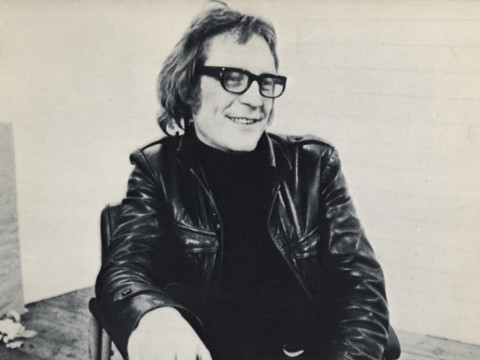
In Memoriam: Antony Green RA
By Timothy Hyman RA
Published on 2 July 2023
Painter Timothy Hyman RA pays tribute to a lifelong narrative-inclined friend and comrade.
Although his art might appear solipsistic, Anthony Green was the most outgoing and responsible of citizens, serving with full engagement each of his communities, including, for over 50 years, the Royal Academy, to which he had first been elected in his early thirties. However funny and entertaining his conversation, he had strong moral principles. Perhaps his deepest commitment was his anti-elitism, opposed to all hierarchy, whether of class or art-world ranking.
He called himself ‘a church-going conservative’ (aware how that might provoke most fellow artists). Brought up by his French mother as a convent-educated Catholic, the 12-year-old Anthony was brutally wrenched from his home at Lissenden Mansions by Hampstead Heath after his parents’ separation, sent away to board up the hill at Highgate School. At 18, he fell passionately in love with a far more glamorous fellow student at the Slade, Mary Cozens-Walker (a year older and several inches taller) converting to her ‘Watford Congregationalist’ dissent. The wondrous project of celebrating that love would last him a lifetime.
As he grew more confident his paintings took on unexpected complexity and monumentality. A fluent French speaker, he looked to the Grandes Machines of The Louvre; but he found another prime inspiration in the assemblies of life-sized figures above the Romanesque doorways of Conques, Vézelay, Autun, marvelling at the way ‘narrative marvelling at the way ‘narrative fitted into their architectural setting.’ Family interiors were thereby rendered ‘epic’ or ‘visionary’, though always with that self-ridiculing edge Gillray called ‘Ye Mock-Sublime Mad Taste’. Anthony could identify his own 20th-century lineage: Stanley Spencer RA (the steep floor, the almost fetishized domestic detail); the slimy ‘finish’ of Otto Dix (‘he knew the power of the object’); and his older exemplar Jeffery Camp RA, who he painted in 1973 and wrote about as ‘a quiet revolutionary’.
After his alcoholic father’s death at Lissenden Mansions, Anthony and Mary would move in: the haunted sitting room of his broken childhood became the blissful bedroom of their naked lovemaking in several Wedding Anniversary images. ‘It has ten walls,’ he wrote. ‘I know every cornice, every skirting-board.’ The catalogue essay to his four-museum Japanese retrospective was entitled ‘Sacred Icons of the Everyday’.

A masterpiece of 1975-76, My Mother Alone in her Dining Room, recorded poignantly her ‘tasteless’ décor as she sits stricken by her second husband’s death and surrounded by reproduction furniture. At the Sainsbury Centre it hangs with The Bathroom at Number 29 (1979), where the clothed Mary reaches a flannel to her vulnerably nude husband in the tub, sharing the narrow space dominated by a meticulous composition of wire coat hangers.
Anthony saw himself as living in ‘a dull lukewarm water Civilisation’; Kentish Town threw up little for the artist by way of Martyrs or Atrocities. He was content to characterise himself as a petit maître, as an eccentric marginal rather than mainstream. Yet we are made to experience each of his altarpiece-scaled constructions as A World. His reinvention of pictorial space had been nurtured by the untrained solutions of schoolboys he taught. As with Chaplin or Woody Allen, Anthony’s exuberant public lectures, delivered in the persona of a stand-up comic, preserved some whiff of permanent adolescence, of arrested development. At the Slade, I had at first cold-shouldered him as Unmodern. (In art schools he was ‘the leper with his bell... They just wanted me to go away’.) Soon I would come to admire his fearless persistence all through two doctrinaire, hostile eras: first of abstraction; and then, whether as conceptual or as feminist, explicitly anti-painting. One of his mantras was: ‘If you want to be a painter, you have to be prepared to go down the street in your Y-fronts.’ Which he did.
Related articles

In memoriam: Norman Ackroyd RA
20 September 2024

In memoriam: Timothy Hyman RA
12 September 2024

In memoriam: Mick Moon RA
1 May 2024

In memoriam: Joe Tilson RA
28 January 2024

In memoriam: Sonia Lawson RA
12 September 2023

In memoriam: Michael Hopkins RA
11 September 2023